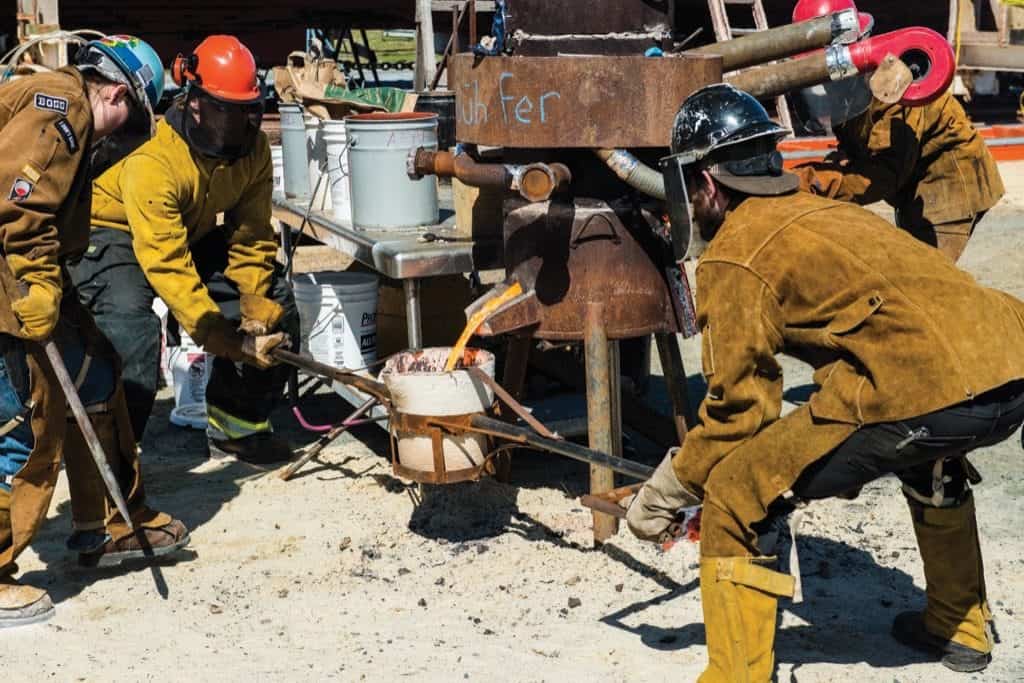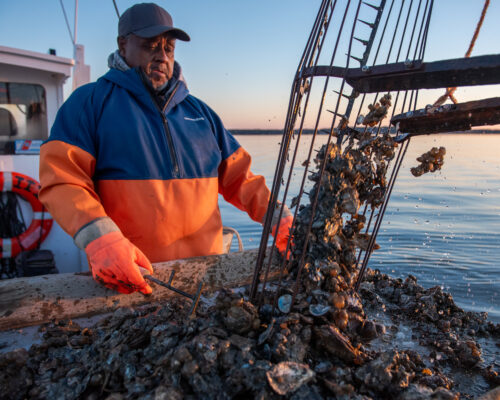Apprentice-for-a-day metal workers heat up St. Mikes
I’m not brave enough to don the leathers. Not that the offer isn’t out there.
“Everybody starts this practice somewhere,” Christian Benefiel, the guest instructor leading the Chesapeake Bay Maritime Museum’s first-ever iron casting, tells the assembled guests. Behind him, a coke-fired blast furnace breathes with a malevolent rumble, while the initiated are going through the ritual of covering nearly every inch of their potentially flammable parts with leather garments, right down to the spats that cover their boots. “We want this to be an inclusive activity, so if you’re doing your first pour, we just ask that you follow someone who’s more experienced. The most important thing you can do today is ask questions.”
It’s early spring, and the museum’s shipyard is humming with excitement under a bluebird sky and a crisp breeze. The night before, several dozen people had taken part in a “sip-and-scratch” event, where they enjoyed some beverages and etched their own designs into 10-by-10-inch scratch blocks—which kind of look like big ashtrays—all the while learning about the art of pouring iron. Designs ranged from starfish to anchors, and now those blocks are laid out side by side on long wooden planks, waiting to have molten iron poured into them.
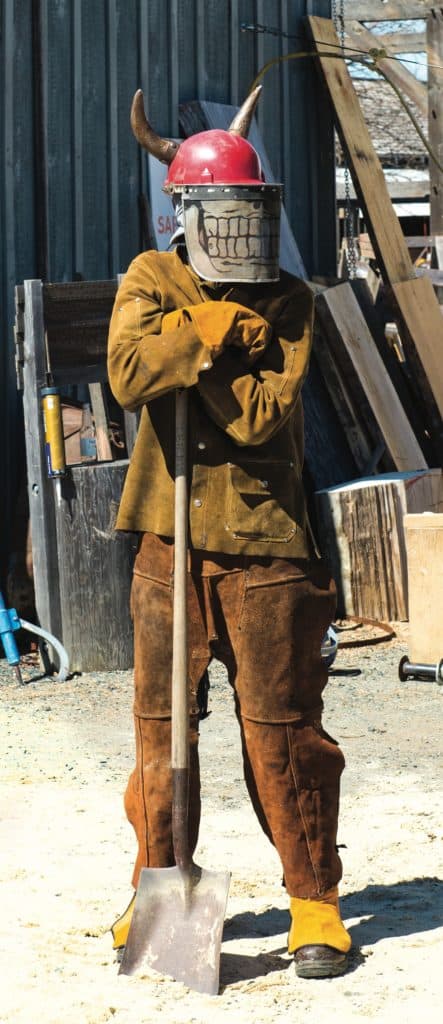
They, along with a variety of other, much larger pieces, including some pillow blocks for the anchor windlass of the museum’s 129-year-old bugeye Edna E. Lockwood, will be forged today in a process that’s fundamentally unchanged for thousands of years, and which Shipyard Programs Manager Jenn Kuhn is thrilled to add to the museum’s expanding Apprentice for a Day (AFAD) program.
“We’re so excited about this,” says Kuhn, who came to the museum in 2011 from Seattle as a shipwright apprentice. “I’ve always wanted to learn metal casting, and it just goes hand in hand with what we do here . . . we’re trying to preserve all of these crafts.”
Apprentice for a Day grew from the museum’s public boatbuilding program, through which people could help the shipwrights with various projects. But it was primarily boatbuilding and restoration, and Kuhn has worked to expand the program into something much more broadly hands-on and topically diverse.
These days, the program ranges from one-day demonstration events, like today’s iron pour, to three- to seven-day intensive hands-on learning sessions in specific skills from a master in the field. One-day events include marlinspike seamanship, in which participants learn sailmaking techniques and leave the class with their own hand-made ditty bag, to navigation, engine repair, and even a class where you can bring your own small boat needing restoration and have the yard’s experts assess whether it will be a dream or a nightmare to accomplish.
Workshops include blacksmithing, brightwork, and introduction to woodworking, while intensives include metalworking, timber framing, and a 10-day skin-on-frame kayak building class. You can even customize a program to meet the needs of yourself or your group for a day or a week of hands-on training.
Kuhn first partnered with Benefiel, a Baltimore native, in 2013, when he came to the museum as an artist-in-residence. A metal sculptor who got into the art as a teenager, Benefiel now teaches sculpture at Shepherd University in Shepherdstown, West Virginia. The recipient of a Maryland State Arts Council Individual Artist Award—among multiple other honors—and a Fulbright grant that took him to Finland, he has conducted residencies at the Academy of Fine Arts in Helsinki and at Pirkkala Sculpture in Finland, as well as the Vermont Studio Center in Johnson, Vermont. His work has been shown in galleries from North Carolina and Maryland to Estonia and Latvia.
He learned about the museum through his wife, a St. Michaels native, and approached Kuhn with the idea of a residency.
“I talked to Jenn, and they hadn’t really done it before, but she said, ‘Let’s give it a try,’” Benefiel says. “She said she’d give me a bench, and I would teach them how to melt and cast bronze.”
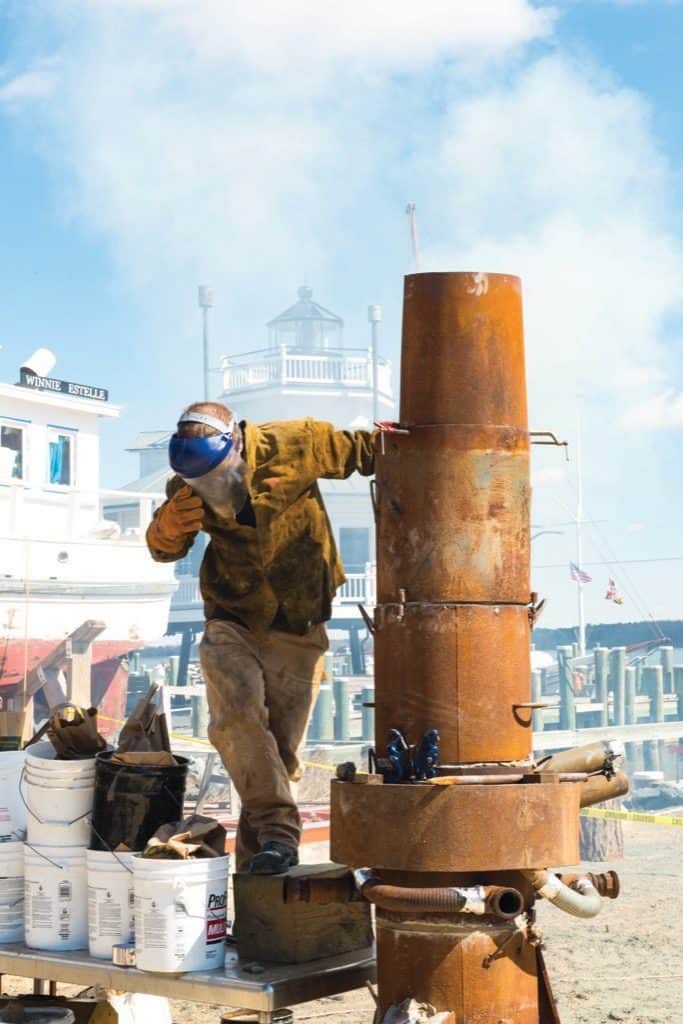
Benefiel now teaches an AFAD workshop in casting bronze and aluminum, and today’s demonstration is taking it to the next level—casting iron. It’s a more intense form of metal work, requiring higher heat, a different furnace and different techniques. Benefiel has brought his portable furnace, a hulking, rusty-looking beast that has a distinct Mad Max vibe to it, thanks to the friend who helped him design it. “He’s a real motorhead,” Benefiel says. “There’s much cleaner ways to do this, but it’s just so cool!”
This furnace is a called a cupola, a style dating to the 1600s, Benefiel says, and named for its long chimney stack with a cupola on top which helps draw the poisonous gases more effectively up and out. Lined with two inches of heat-resistant refractory, rated to about 3,200 degrees Fahrenheit, it can be dismantled by section, which makes it portable.
Standing on thick metal legs, it has four primary vertical sections stacked atop one another: At the base is the well where the molten iron pools before being tapped; above that, the wind belt, which is basically a complex bellows comprised of multiple wrapped and curved pipes (hence, the Mad Max look), some of which end with cap nuts that are removed periodically to poke the fire with lengths of rebar, as well as to attach blowers to pump air into the furnace; the melt zone where the serious combustion takes place (more on that in a moment), and at the top, the chimney.
The whole thing stands about 12 feet tall. Next to it is a metal table stacked with drywall buckets, each containing a “charge” of six pounds of foundry coke—blocks about the size of a big fist, nearly pure carbon that burns clean at high temperatures—and 35 pounds of iron; mostly broken up old radiators, bathtubs, and the like.
Today, 600 pounds of iron will go into the furnace in these individual charges, and it will melt amid the burning coke, flow into the well, and come out 75 to 80 pounds at a time—about every 10 to 15 minutes—as a boiling-hot, fluorescent, orange liquid.
Furnaces, Benefiel explains, each have their own character and idiosyncrasies, and there’s a certain amount of superstition about them. I begin to understand why as I watch Benefiel and several others—some with the museum, others metal artists and former students of Benefiel who are casting art pieces today—slowly bring the furnace to life, a process that takes several hours and has the same kind of excited, jovial teamwork as a barn-raising.
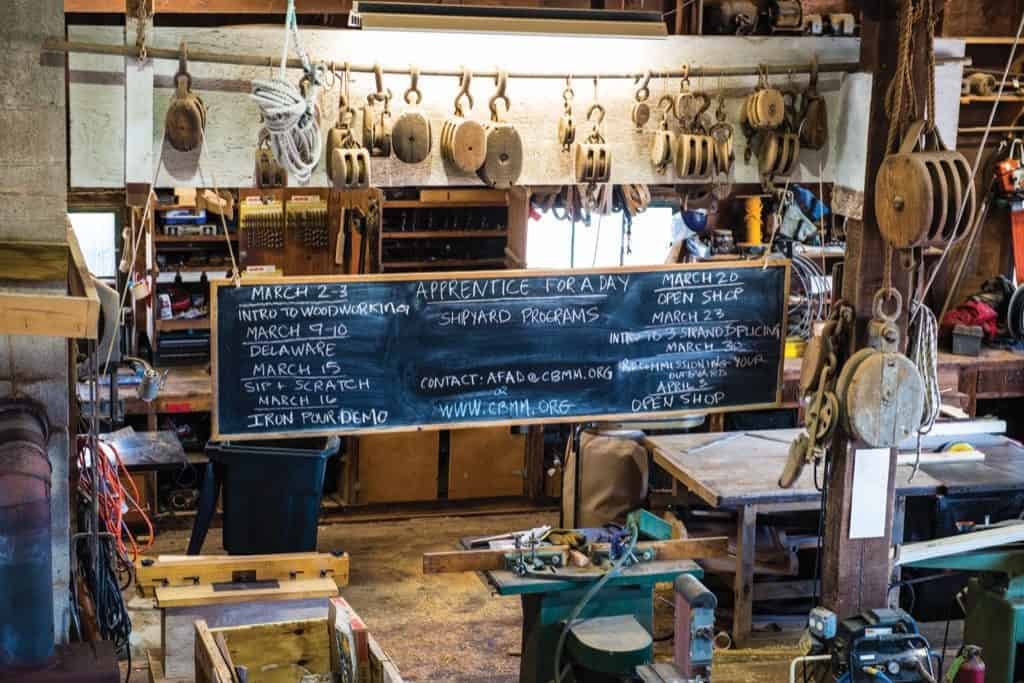
“Iron is more of a community activity; you really can’t do it alone,” Benefiel says. “This iron community is a collection of loveable maniacs. Well, maybe not loveable, but maniacs!”
“We have iron coursing through our veins, every one of us,” says Lauren Koch, who’s in the University of Maryland’s three-year, studio art master of fine arts program . Today, she’s casting a piece for her mid-program project, called “Residium.”
To get things rolling, Benefiel starts with a wood fire, some blocks of coke and a few spritzes of lighter fluid. Adding a blower to the windbelt gets the fire hotter, and then Benefiel tosses chunks of coke down the top of the stack. By the time he starts adding charges—standing on the table and pouring the contents of the buckets straight down the chimney—the others have spread sand all around the work area, laid out the molds in pour lines, and begun to don the leather, face shields, and other gear that will protect them from the fire, heat, and molten metal.
There’s a certain ritualistic feel to the whole exercise, not least because of the nature of the beast. At 2,600 degrees, the iron starts to melt. 2,800 degrees is when you pour. And through it all, the furnace gains heat, momentum, and a kind of barely contained power that’s absolutely mesmerizing. By the time the pouring starts, the furnace is a living, roaring god which demands its supplicants’ full attentiveness and care.
At least two people are at all times tending to it, unscrewing cap nuts on the wind belt to poke and stir the fire, or poking and clearing the slag hole at the top of the well. As the well fills with molten iron, the iron initially dribbles out of the slag hole and indicates, depending on its consistency, when it’s ready to pour from the tap near the well’s base on the opposite side.
Sparks and the occasional chunk of debris fly out of the slag hole, and from 30 feet away, the heat is palpable. What had been smoke coming out the chimney is now pure, shimmering heat.
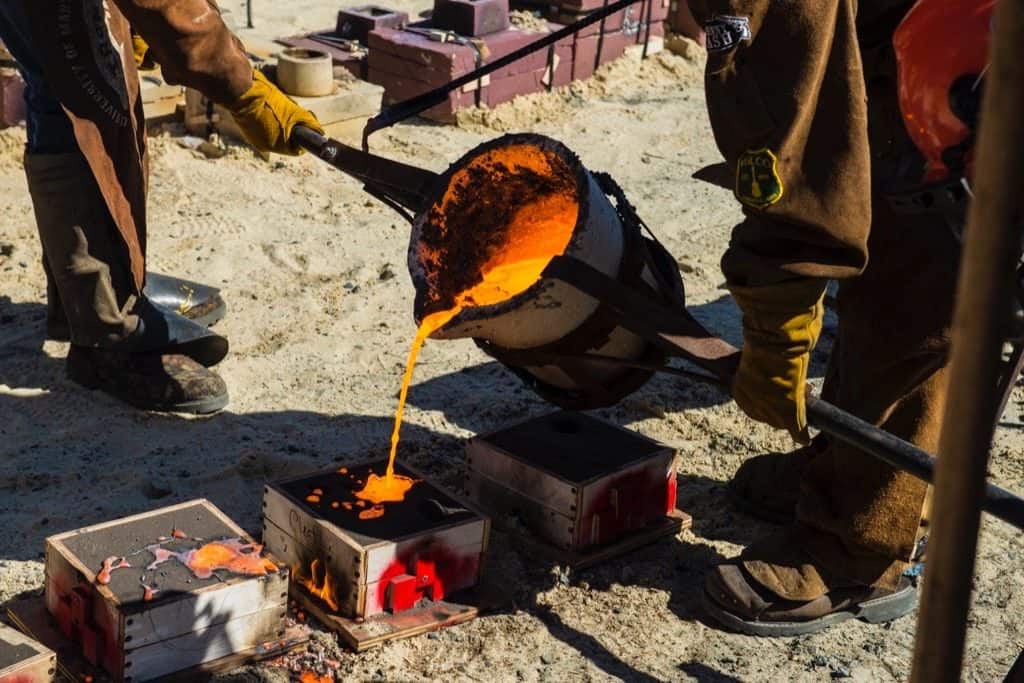
As the first pour nears, Benefiel gathers everyone around and goes over who will do what. The pour team is in charge of handling the refractory bucket, catching the iron from the tap and then moving to the pour line and pouring the molten metal into the various molds. Others are charged with the simultaneous opening of the tap, which is plugged with a wad of sand and refractory material called a bod, and closing off the slag hole—a process that’s reversed as soon as the pour is completed. The skimmer skims slag and impurities off the surface of the molten iron just after it goes into the vessel, and then, during pouring. The choreography is precise and careful.
At about 1:30—some two hours after Benefiel started the fire—Matt Engel, lead educator at the museum, who had spent hours preparing the sand mold for the Edna Lockwood’s pillow bearings, shouts as what had been a sticky sludge of molten metal at the slag hole suddenly starts running as thin and liquid as water.
“Ok, let’s open it!” Benefiel says, and the team moves quickly into position. Using a thick iron bar, Benefiel stabs away the bod that has sealed the tap. Suddenly it bursts open, and a startling stream of brilliant orange liquid gushes wildly from the tap into the bucket. As soon as the bucket is full enough, he plugs the tap with another bod as the pour team—led by Kuhn at the “live end” of the bar holding the bucket—moves carefully to the row of molds and starts pouring.
This process repeats about every 10 minutes, about eight times. Between pours, they switch roles so that everyone gets experience at each job, discussing the choreography of the pour each time. Every now and then something will catch fire—a wooden edge of a mold, the top of someone’s leather-covered boot—and it’s quickly and nonchalantly doused with sand.
After the final pour, they disconnect the blower on the wind belt, open all of the cap nuts on the pipes, and then pop the bottom of the well open. The last of the red-hot coke drops to the sand below, a volcanic pile until someone sprays it down with water. And just like that, the beast is quieted, still shimmering hot, but withdrawing into somnolence again.
Tomorrow, Kuhn, Benefiel, and the others will return to open the molds and see how they did. “It’s kind of like Christmas,” Kuhn says, “you don’t know what you’ve got till you open it.”

